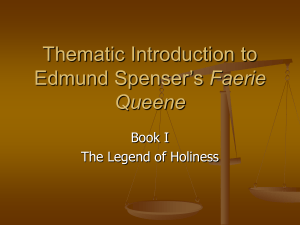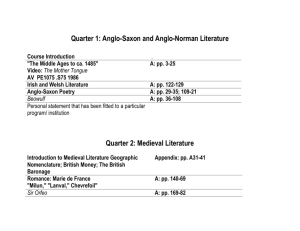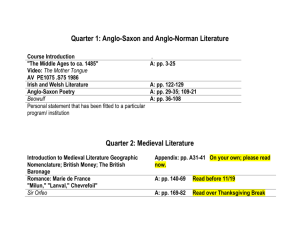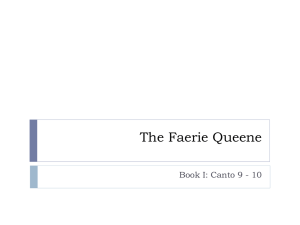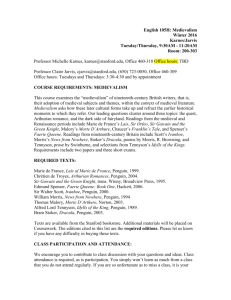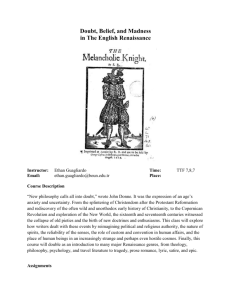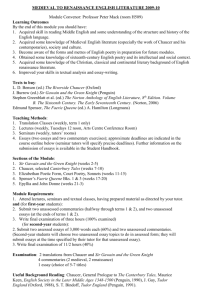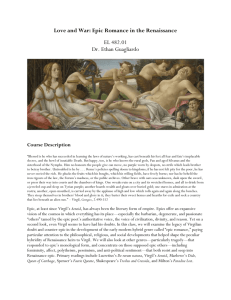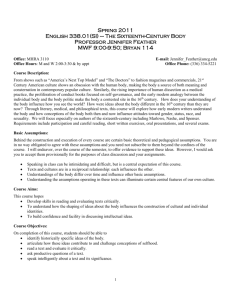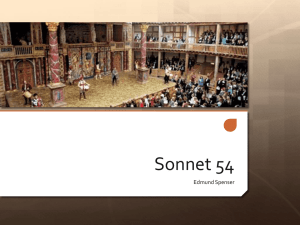The Faerie Queene, Book 1, Cantos 1-6
advertisement
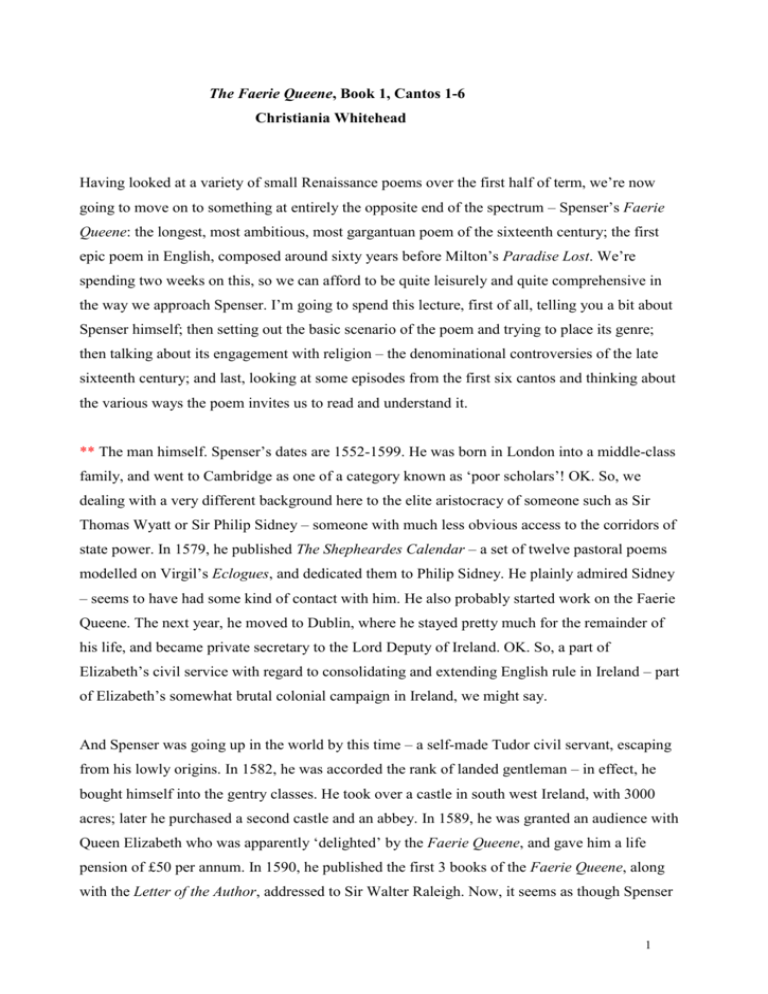
The Faerie Queene, Book 1, Cantos 1-6 Christiania Whitehead Having looked at a variety of small Renaissance poems over the first half of term, we’re now going to move on to something at entirely the opposite end of the spectrum – Spenser’s Faerie Queene: the longest, most ambitious, most gargantuan poem of the sixteenth century; the first epic poem in English, composed around sixty years before Milton’s Paradise Lost. We’re spending two weeks on this, so we can afford to be quite leisurely and quite comprehensive in the way we approach Spenser. I’m going to spend this lecture, first of all, telling you a bit about Spenser himself; then setting out the basic scenario of the poem and trying to place its genre; then talking about its engagement with religion – the denominational controversies of the late sixteenth century; and last, looking at some episodes from the first six cantos and thinking about the various ways the poem invites us to read and understand it. ** The man himself. Spenser’s dates are 1552-1599. He was born in London into a middle-class family, and went to Cambridge as one of a category known as ‘poor scholars’! OK. So, we dealing with a very different background here to the elite aristocracy of someone such as Sir Thomas Wyatt or Sir Philip Sidney – someone with much less obvious access to the corridors of state power. In 1579, he published The Shepheardes Calendar – a set of twelve pastoral poems modelled on Virgil’s Eclogues, and dedicated them to Philip Sidney. He plainly admired Sidney – seems to have had some kind of contact with him. He also probably started work on the Faerie Queene. The next year, he moved to Dublin, where he stayed pretty much for the remainder of his life, and became private secretary to the Lord Deputy of Ireland. OK. So, a part of Elizabeth’s civil service with regard to consolidating and extending English rule in Ireland – part of Elizabeth’s somewhat brutal colonial campaign in Ireland, we might say. And Spenser was going up in the world by this time – a self-made Tudor civil servant, escaping from his lowly origins. In 1582, he was accorded the rank of landed gentleman – in effect, he bought himself into the gentry classes. He took over a castle in south west Ireland, with 3000 acres; later he purchased a second castle and an abbey. In 1589, he was granted an audience with Queen Elizabeth who was apparently ‘delighted’ by the Faerie Queene, and gave him a life pension of £50 per annum. In 1590, he published the first 3 books of the Faerie Queene, along with the Letter of the Author, addressed to Sir Walter Raleigh. Now, it seems as though Spenser 1 had very high hopes for what the publication of these books would do to his status. The Faerie Queene is a poem in praise of Elizabeth. Basically, Spenser wanted to be a court poet; he hoped for the same kind of proximity to Elizabeth as a Raleigh or a Sidney. But it didn’t work. It didn’t get the acclaim he had hoped for. He remained an obscure civil servant in Ireland. By the time books 4-6 were published in 1596, there’s the sense that slight disillusionment has set in – that the poem is struggling to sustain the initial idealism and ambition that drove its genesis. The Faerie Queene was originally intended to be 12 books long, but Spenser never completed more than these first 6 books. ** In 1598, he was swept up in and driven from Ireland by the Irish rebellion against English rule known as Tyrone’s rebellion. His castle home in south west Ireland was burnt and sacked. There is a dreadful passage in a letter by Ben Jonson that describes what may have happened to Spenser: ‘that the Irish having robbed Spenser’s goods and burnt his house and a little child new born [the poet’s?], he and his wife escaped [to England], and after, he died for lack of bread in King Street.’ Spenser’s circumstances may not have been quite so destitute as Jonson implies, but he was certainly dead in London by January 1599. On the face of it, a broken man. His great poem insufficiently acclaimed; his life’s work of setting himself up as a gentleman via the acquisition of estates – in tatters. Nonetheless, by 1620, he had his own funeral plaque in Westminster Abbey: ‘to the Prince of Poets of his tyme’, and The Faerie Queene has never been out of print since. Back to Spenser’s high hopes and original intentions in the late 1580s. What is the basic scenario of the poem? What is its overall structure and purpose? And we are going to find his Letter of the Authors very useful here – so please do read it, if you haven’t already. ** First and foremost, and I’ve said this already but I’m going to say it again, this is a poem designed to praise Elizabeth, and to win favour and patronage from her. ** She is the Faerie Queene. Elizabeth underlies and dominates the poem. Yet she is never directly physically present within it. We hear about the Faerie Queene at various junctures. Knights have dreams about her. They ride in search of her. They come from her court. Yet she never physically appears. Spenser is making a comment about both the transcendence and inaccessibility of the Tudor monarch. ** Second, this is a poem designed ‘to fashion a gentleman or noble person in vertuous and gentle discipline’. And one might think that Spenser, having just fashioned himself as a gentleman (getting a gentry rank, buying up land), might be very personally fascinated by this. But of course, in the idealised world of the Faerie Queene, one doesn’t become a gentleman, a courtier, by buying up land, ** rather one becomes a gentleman by perfecting oneself in the twelve moral virtues. So each of the twelve books of the Faerie Queene, in the original design, was intended to teach the reader about 2 one of these moral virtues – the first book about holiness, the second book about temperance, the third book about chastity, and so on. Once you had become perfectly educated in all twelve moral virtues – i.e. once you had read all twelve books of the Faerie Queene, and read them properly, you would be a gentleman – i.e. a perfected refined, moral, courtly sort of person. A natural aristocrat, one might say! So, here is Spenser, this self-made civil servant, writing a kind of instruction manual, telling the reader how to achieve perfect courtly refinement based on virtue. However, The Faerie Queene doesn’t just sit down and tell us about the character of holiness and temperance, does it. It fictionalises these precepts. Redcrosse, in book 1, becomes the knight of holiness, riding off from the court of the Faerie Queene, after Una has arrrived seeking help, on a long quest to kill the dragon who is holding her parents captive. Guyon, in book 2, is the knight of temperance, riding off from the court of the Faerie Queene to capture the wicked enchantress, Acrasia. etc. etc. And Spenser seeks to justify doing things this way by saying in his Letter of the Authors: ** To some I knowe this Methode will seeme displeasaunt, which had rather haue good discipline deliuered plainly in way of precepts, or sermoned at large, as they use, then thus clowdily enwrapped in Allegoricall deuises [Spenser is seeming to presume a disapproving Puritan reader here, who doesn’t approve of fiction]. But such, me seeme, should be satisfide with the use of these dayes, seeing all things accounted by their showes, and nothing esteemed of, that is not delightfull and pleasing to commune sence. For this cause is Xenophon preferred before Plato [that is, an ancient Greek fictional biographer over an ancient Greek philosopher] … So much more profitable and gratious is doctrine by ensample, then by rule. So, Spenser uses the mechanism of fiction, specifically of allegory, not because his basic purpose in writing is not didactic, instructional, but because one teaches better when one succeeds in delighting, and one delights more by fiction than by setting a list of moral precepts. Sidney says much the same thing in his Defense of Poetry. So each book entails a knight who embodies a different moral virtue, leaving the court of the Faerie Queene, and pursuing a quest, both to demonstrate that virtue in action, and to grow into it. Redcrosse isn’t all that holy at the beginning of book 1. Cantos 1-6 are largely filled with his mistakes. By canto 12, he is a bit more holy. Two ideas here. One, that all the twelve moral virtues are sourced at the court of the Faerie Queene, i.e. that they originate with her, with Elizabeth. Two, that while Elizabeth may be their transcendent source, it is young men, young 3 male courtiers, who actualise them, who put them into action. Elizabeth’s power (and virtue) is physicalised, played out, through men. That’s half of the Letter of the Authors. The other half is that confusing bit about Prince Arthur: I labour to pourtraict in Arthure, before he was king, the image of a braue knight, perfected in the twelue priuate morall vertues … Arthure: whom I conceiue after his long education … to haue seene in a dream or vision the Faery Queen, with whose excellent beauty rauised, he awaking resolued to seeke her out, and so being by Merlin armed, and by Timon throughly instructed, he went to seeke her forth in Faerye land … in the person of Prince Arthure I sette forth magnificence in particular, which vertue for that (according to Aristotle and the rest) it is the perfection of all the rest. As well as a knight riding out from the court of the Faerie Queene in each book, to kill his dragon and demonstrate holiness or whatever, we also have, in each book, a countrapuntal movement – Prince Arthur (King Arthur-to-be), is riding in search of the Faerie Queene whom he has seen in a vision. The two knights tend to intersect in Canto 7. So you won’t meet Arthur this week, but you will next week. In fact, he appears in every book at Canto 7. He is the one continuous thread running through all the books of the poem. And the implication is that, when he finally finds the Faerie Queene, he will marry her. What is going on here? King Arthur of ancient British legend is threading through this Renaissance poem, looking for Queen Elizabeth in order to marry her. Well, I think we have to approach this as an instance of Tudor nationalism, Tudor propaganda at work. The Tudor dynasty was relatively recent, relatively insecure. For Catholics, Elizabeth was not a legitimate queen at all – Henry VIII’s marriage to Catherine of Aragon should never have been annulled. How compelling then to show Elizabeth as the sought-after bride of the legendary king of ancient Britain .. to link the Tudors to ancient British greatness. Arthur’s pursuit of Elizabeth vindicates her as the kind of endpoint of the Arthurian golden age. And his anticipated marriage of her suggests a marrying of past national splendour with present glory to create a future golden age. For those of you who study epic, I think Spenser here is doing something not entirely dissimilar to the way Virgil constructs Aeneas and Augustus. Do you remember that he locates Augustus as the kind of anticipated endpoint or fulfilment of Aeneas’s founding endeavours. An invisible line is drawn between legendary past and political present. So, there’s something very Virgilian going on here. And that ties into the next point I want to make – moving away from the Letter of the Authors now, about the hybrid genres of the poem. 4 ** So, number one, predictably enough, The Faerie Queene is an epic. Quite a lot more like Virgil than like Homer – a poem giving an account of the greatness of the British nation. And Spenser has a very very conscious sense of himself as an English Virgil. Do you remember how I said earlier that he wrote a set of pastoral poems in the late 1570s, The Shepheardes Calendar modelled on Virgil’s Eclogues. Well, its not just that he models a particular set of poems, he models a whole career! In the Dedicatory Epistle to the Shepheardes Calender, an anonymous friend of Spenser writes that ‘our young poete’ follows the example of the best ancient poets, such as Virgil, in writing a pastoral poem to test his abilities ‘as young birdes, that be newly crept out of the nest, by little first to proue theyr tender wyngs, before they make a greater flyght’. And in the very first introductory stanza of Book I of the Faerie Queene, speaking in his own person, Spenser refers to this transition from pastoral to epic again: Lo I the man, whose Muse whilome did maske, As time her taught, in lowly Shepheards weeds, Am now enforst a far unfitter taske, For trumpets sterne to chaunge mine Oaten reeds, And sing of Knights and Ladies gentle deeds. Spenser’s Muse used to wear shepherd’s clothes and play the reed pipes of pastoral poetry. Now it blows the stern trumpets appropriate to epic utterance. So – epic devices! Starting in media res: not at the court of the Faerie Queene, but halfway into the quest. The visit to the Underworld in Canto 4: wicked Duessa and Night go down to Hades to find healing for Sansjoy who has been wounded by Redcrosse. But also notice how Spenser makes revisions and criticisms of epic from the standpoint of Christian belief – very like Milton. In Canto 6, Una, whose name means Oneness, the Oneness of Christian truth contained within the reformed Christian church, is captured by Fauns and Satyrs, simple woodland spirits, straight out of a classical poem or eclogue. And these little classical creatures are kind to Una; they are open to learning from her; they are receptive to the Christian Truth; but they are also very childlike, very primitive, by contrast with her. The religious beliefs of classicism are child-like and primitive by contrast with the radiant refinement of reformed Christianity. A second more critical example. In Canto 4, Redcrosse: fallible British holiness, visits the House of Pride – he becomes proud, in other words, after being separated from Christian Truth. He escapes eventually after his attendant dwarf tells him about the horrors of Pride’s dungeon – the victims of Pride who lie rotting there. ** Amongst the victims of Pride: All these together in one heape were throwne, Like carkases of beasts in butchers stall. 5 And in another corner wide were strowne The antique ruines of the Romaines fall: Great Romulus the Grandsyre of them all, Proud Tarquin, and too lordly Lentulus, Stout Scipio, and stubborne Hanniball, Ambitious Sylla, and sterne Marius, High Caesar, great Pompey, and fierce Antonius. (I, IV.49) Virgil would be turning in his grave – his whole Roman heroic genealogy – Romulus, Julius Caesar and all the rest, judged proud and hence sinful, from A Christian viewpoint. Milton does a lot of the same stuff, makes a lot of the same criticisms, in Paradise Lost. ** The Faerie Queene is epic; it is also romance, in the medieval meaning of the term. Hence, knights ride off on quests to kill dragons for ladies in distress, killing a few Saracens along the wayside – the crusades against Muslim warriors in the Holy Land were popular subjects within medieval romance. Hence, the notably archaic language – Spenser uses lots of words that are distinctly old-fashioned for the late sixteenth century. Hence, the Arthurian subject matter. Hence, the deference to Chaucer. Because the story of Arthur having a vision of the Faerie Queene in a dream, and riding off in search of her, is actually a loose version of the plot of Chaucer’s Tale of Sir Thopas, from The Canterbury Tales. Sir Thopas, who is a very silly character, has a dream of an ‘elf-queene’ and rides off to the ‘countree of Fairye’ to make her his wife. In Book 4 of the Faerie Queene, Spenser addresses Chaucer directly, and implies that Chaucer’s spirit lives on in him in some way: ‘.. that renowned Poet .. Dan Chaucer, well of English undefyled, On Fames eternall beadroll worthie to be fyled. .. Then pardon, O most sacred happie spirit, That I thy labours lost may thus reuiue, And steale from thee the meede of thy due merit, That none durst euer whilest thou wast aliue, And being dead in vaine yet many stiue: Ne dare I like, but through infusion sweete Of thine owne spirit, which doth in me surviue, I follow here the footing of thy feete, That with thy meaning so I may the rather meete. (Book 4, canto 2.32, 34) Spenser locates himself as an English Virgil. He also, respectfully locates himself as a latter-day Chaucer. He blends medieval and classical into an astonishing Renaissance synthesis. 6 The Faerie Queene is indebted to medieval romance. But at the same time, it is not your run-ofthe-mill Wife of Bath’s Tale, or Sir Gawain and the Green Knight. ** Because it is also an allegory. It is an example of a literary form which gives a body to different psychological and moral ideas, and to different aspects of the self. A literary form which makes various abstract ideas concrete. Of course, in such a form, where the abstract is made concrete, it is often very tempting for the reader to forget what these characters mean, to stop making the effort of continuous decoding, and to respond to them on too literal a level. To treat them as though they were real people, with a 3-dimensional psychology. As a result, I want to suggest that the perspectives of allegory and the expectations of romance often exist in a kind of tension with one another in this narrative. For example, in canto 1, whereas it is good for a medieval knight to fight a monster in a wood, demonstrating his bravery, here, Redcrosse is engaging with Error – he is engaging with the possibility of understanding Christian doctrine erroneously, and that’s not a battle he should be participating in in the first place. He should have stayed well away from Error. In a battle in a normal medieval romance, it is physical strength that allows you to overcome a monster. Here, physical strength doesn’t help Redcrosse one whit. It is not until Una cries: … Now now Sir knight, shew what ye bee, Add faith unto your force, and be not faint. (Book I, canto i.19) Until Redcross adds faith – good, strong reformed Christian faith - to his arsenal, that he acquires the kind of power capable of exterminating Error. Another example – the tournament at the House of Pride in Canto 5, where Redcrosse fights Sansjoy, with Duessa aiding and abetting each side from behind the scenes. Its easy to want to respond to this as though it were a standard medieval tournament. It is harder to keep a handle on the fact that at this tournament Redcrosse is fighting Sansjoy – his own tendency to joylessness or despondency, now that he has lost touch with reformed Christian Truth (Una), and allied himself to Duessa – Doubleness or Falsity. He is fighting an aspect of himself. His depression, if you like. As readers, we too will run into error if we persist in taking too literal a view of things. Decoding is required all the time. Allegory was used right through the Middle Ages, in both secular and religious poetry. As such, it is often seen as a Catholic poetic device. Something designed to give body and vividness and memorableness to Catholic moral teaching. Nonetheless, despite using this most Catholic and most medieval of religious poetic forms, Spenser was virulently anti-Catholic. Unusually, unexpectedly even, he diverts allegory to serve a fervently Protestant agenda. ** So, its to the question of religion in the poem that I want to turn now, and to the particular question of 7 denominational conflict. These denominational conflicts can seem hard for us to get a handle on nowadays. We have to remember, as Paul told us in week 3, that this was an age where bishops were being burnt at the stake under Henry VIII for their Catholic allegiance; under Mary I, for their Protestant allegiance. Where French Catholics had killed approximately 30,000 French Hugeneots or Calvinist Protestants in France in 1572, in the atrocity known as the St Bartholomew’s Day massacre. Where Elizabeth lived with the ongoing anxiety of Catholic plots designed to overthrow her in favour of her Catholic cousin, Mary, Queen of Scots. One of the most major of these plots, the Babington Plot, uncovered in 1586, in the midst of the Faerie Queene’s composition. ** With Spenser’s Protestantism in mind, first, its important for us to be clear that Redcrosse riding with Una, at the beginning of Book 1, represents British holiness allied to the one true church – the Protestant church! While these two stay together nothing much can assail them. Together, by the end of the book, they will prove capable of taking on and killing the dragon, Satan himself. In addition, derogatory references to Catholic practices aren’t hard to find. You might remember the old woman, Corceca in Canto 3 (her name means ‘blind of heart’), who fasts and wears ashes and sackcloth, and mumbles multiple Pater nosters in the darkness of her hovel (all these practices were condemned by Protestants). And her daughter, Abessa (plainly the abbess of a convent) who is brought money and jewellry stolen from churches by Kirkrapine, in return for prostituting herself with him. OK. Keying into standard sixteenth-century Protestant propaganda about how monasteries were rich and corrupt and parasitic, and where did God say anything about living the monastic life in the Bible anyway?! The two more complex depictions of Roman Catholicism in Book 1 are a bit harder for a twentieth-first-century reader to detect. And it’s easy to miss them. First, Archimago. Suspicious signs – he’s on the road, beating his breast, behaving like a pilgrim (pilgrims are bad from a Puritan viewpoint); he lives in a hermitage (hermits are bad; they’re a bit like monks); his afterdinner conversation: He told of Saintes and Popes, and euermore He strowd an Aue-Mary after and before. (Book 1, i.35) Clear signs of Catholicism here. But the main thing about Archimago – and he is clearly a very formidable, very dangerous magician – is that he is an image-maker. He furthers his ends – the separation of Redcrosse from Una – by making false images. And not only are these images empty, insubstantial, they are also seductive and erotic. If you remember, Archimago first gives 8 Redcrosse a dream in which a fake Una comes to his bedroom and attempts to seduce him. Then he prepares a second set of images in which Redcrosse is shown Una enjoying herself in bed with another man. Catholics and sexy images? The point, and it is again a very sixteenth-century one, is that Protestants found Catholics’ use of images – of sculptures, stained glass, paintings, extravagent church architecture, the theatrical spectacle of the Latin mass, distracting and misleading. And that they tended to articulate their disapproval in emotive, sexually-charged terms. These images seduced the hearts of innocent believers through their sensuality; through their pleasurable appeal to the channels of the senses. Archimago is a demonic image-maker. A constructor of misleading illusions. His role is to break the partnership between Redcrosse and Una – between Britain and Protestantism, via the means of these illusions. And of course he does that very successfully for a time. ** The second more complex depiction of Roman Catholicism is Duessa. And again, I want to look at this in some detail. Duessa means Doubleness, doesn’t it, set against Una’s Oneness. With Doubleness always come the idea of Falsity, of seeming what you’re not. So we’re told at the end of canto 2 that when Fradubio sees Duessa washing one day (he’s the guy who turns into a tree after getting together with Duessa), instead of looking all beautiful and honeyed and young, he finally sees her for what she really is: A filthy foule old woman I did vew, That euer to haue toucht her, I did deadly rew. Her neather partes misshapen, monstruous, Were hid in water, that I could not see, But they did seeme more foule and hideous, Then womans shape man would beleeue to bee. (Book I, canto ii.40-41) Beautiful and young on the outside. Repulsive and old underneath. However, as well as representing Falsity, I also want to suggest that Duessa is based on the image of the whore of Babylon in the Book of Revelation, the last book of the Bible, where St John the Divine is shown a vision of the last times, of the Apocalypse. In Canto 2, when we meet Duessa for the first time, in the company of Sansfoy, the Saracen knight, we are told that she is: A goodly Lady clad in scarlot red, Purfled with gold and pearle of rich array, And like a Persian mitre on her hed She wore, with crownes and owches garnished, The which her lavish louers to her gaue. (Book I, canto ii.13) 9 Next week, in canto 7, we will discover that her next lover, a giant called Orgoglio, dresses her in gold and purple, puts a triple crown on her head, and seats her on a seven-headed beast. ** Lets look first of all at the relevant verses from the Book of Revelation. (This is from the Geneva Bible of 1560): ‘I sawe a woman sit upon a skarlat coloured beast, full of names of blasphemie, which had seven heads, and ten hornes. And the woman was araied in purple and skarlat, and guilded with golde, and precious stones, and pearles.’ She is subsequently named ‘great Babylon, the mother of whoredomes.’ (Rev.17.3-5). The fit is fairly good, isn’t it. Now, lets look at the Geneva glosses to these biblical verses – these were glosses added by sixteenthcentury Swiss Calvinists, interpreting the Bible from the standpoint of low-church Protestant theology: ‘this woman is the Antichrist, that is, the Pope with the whole bodie of his filthie creatures … whose beautie onely standeth in outwarde pompe and impudencie and craft like a strumpet … the beast signifieth the ancient Rome; the woman that sitteth thereon, the new Rome which is the Papistrie, whose crueltie and blood sheding is declared by skarlat.’ This can all seem quite complicated. The thing you need to take away from this is that Duessa is intended as a representation of the Whore of Babylon, and that, for 16th century Protestants, the Whore of Babylon equalled the Roman Catholic Church. So, when Redcrosse deserts Una and takes up with Duessa, he is allying himself with promiscuous Roman Catholicism. British holiness is taking a wrong turn. When Duessa takes him to the House of Pride, what Spenser is saying is that Roman Catholicism is proud and haughty, and leads in quick succession to the seven deadly sins, and to hell. When Duessa heals Sansjoy after the tournament, what Spenser is saying is that Roman Catholicism engenders joylessness or depression in the Christian soul. All very polemic; and all part of an Elizabethan climate of denominational invective that can seem very alien to us now. ** Finally, I want to close with one or two words about how we are intended to read the Faerie Queene, and about how our moral education is intended to work. Remember – the text is intended to teach us morality – to fashion us as gentlemen. So. How does the poem teach us? What methods does it use? Well first, it frequently teaches us the nature of a vice or a virtue straightforwardly, via its name and external appearance. Its not hard to tell that a monster spewing gobbets of filth is going to mean something horrible – Error, or that a deformed creature swollen with fat, riding on a pig, is likely to represent Gluttony. We and Redcrosse look and learn. We read the visual image, and we learn something about the monstrous disposition of Error or the repulsiveness of Gluttony. These are not difficult 10 lessons. Second, some of the time, Spenser makes use of an emblematic method, which probably felt easier for Renaissance readers, at a time when emblem books were very popular, than it does for us as twenty-first century readers. In these instances, he sets a number of conventional symbolic images in play alongside each other and leaves the visual decoding up to us. So, for example, that initial scene of a knight wearing dented armour, accompanied by a lady on a donkey dressed in white but veiled in black, leading a milkwhite lamb. The individual ingredients of this scene are never named. It is left to us to work out that Redcrosse is dressed in the armour of the Christian faith, that the lady on the donkey represents Christian Truth mounted on humility, that the milk-white lamb she is leading symbolises Christ, the lamb of God. In other words, that when British holiness is allied to reformed Christian Truth, to the one true church, it has a hotline to God. As I say, a medieval or Renaissance reader, trained in responding to images symbolically, would probably have found this far more straightforward than we do. The third and most challening way in which Spenser teaches us is when he doesn’t name his characters for a long time, but leaves us to try and work them out for ourselves through their actions, and perhaps even, to read them wrongly. The most problematic figures to decode, unsurprisingly enough, are the figures associated with Falsehood and Hypocrisy – Duessa and Archimago. It is possible for us to stay with the misleadingly attractive appearance of these characters for several pages – overlooking the tiny signals that should alert us – before they are finally named, and their true natures come into relief. We are deceived, just as Redcrosse and Una are deceived, because we have not read discerningly enough. We have overlooked the element of excess and gaudiness in Duessa’s appearance; missed the Catholic paraphrenalia of Archimago’s home. We get it wrong as readers, for a time we are led astray. More quickly than Redcrosse and Una we realise our mistakes. We learn the ethical imperative which Spenser is trying to teach us, of reading with suspicion, of not being taken in by appearances, in a textual and moral climate in which the greatest anxieties of the age seem focussed upon the disjuncture between seeming and being, and between appearance and substance. Thank you. 11
